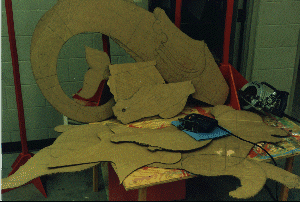

Template
The template will be used to draw lines and fit the
wood you have to your design. You will refer to it often in the
preliminary glue-up stage. Later on, when your animal is whole,
it can serve as a place to lightly sketch in designs and ideas
for trappings and decorations. Always save your templates, they
are a record of your process.
Draw in lines for the direction of the grain in the wood. The grain should always be working for you in two major ways; first, strength, long grain is stronger that short end grain and secondly, ease of carving. One likes to be carving "downhill" and not have conflicting grain patterns, especially within the same laminated piece.
So, design and build your animal with the grain in mind, always!
Note: Gluing end-grain butt joints is very weak also and must be avoided, it this does need to happen, for instance when attaching a leg or leg joint or ear, etc., then it must be assisted by additional jointing work such as mortise and tenon and/or wooden dowels. Avoid putting metal screws or nails in your work as this metal will attract moisture and eventually rot the wood around it AND if you are carving and run into a metal fastener your chisel will not be very happy.
 |
|